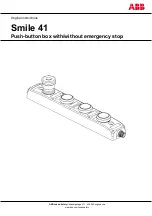
3. OPERATING PRINCIPLES
GEK-106243E
DTP Digital Transformer Protection
3-1
3. OPERATING PRINCIPLES
3.1 DESCRIPTION OF THE GENERAL OPERATING PRINCIPLE
The basic principle of current differential protection is illustrated in Figure 7.
When equal currents exist on both sides of the protected element in the directions indicated by Figure 7, as in the
case of an external fault, no operate current will flow in the relay.
In the case of unequal currents, the difference between I1 and I2 is the operate current. When an internal fault
occurs a direction reversal occurs, as reflected in Figure 7. Assuming perfect CT performance, any overcurrent
relay with adequate characteristics can be used as the differential relay.
For high magnitude external faults, the impossibility of obtaining a completely balanced differential circuit due to
the differences in the CT outputs makes the special characteristics provided in the DTP necessary. To prevent
operation on these unbalances, a current differential relay with percentage restraint is used. The differential or
operate current is a variable quantity, due to the effect of the restraining currents. The smaller of the restraint
currents is called the “through current.” The differential current required to operate the relay is a fixed percentage
of the through current. As the through current increases, the level of differential current must increase to operate
the relay.
Figure 8 represents the block diagram of the relay.
The operation of the DTP relay is described by the following equation:
[ G
d
(I
1
- I
2
)
f
- G
f
(I
1
+ I
2
)
f+h
- G
a
(I
1
- I
2
)
h
- S ] > 0
For a three-phase transformer with two windings, the relay contains two current transformers per phase, one on
each side of the transformer. From these currents the differential current and the through current are calculated.
Additionally, each phase current is filtered, which will be explained later on, to extract select harmonics. The
magnitude of these harmonics is used to discriminate between fault conditions and the inrush of exciting current to
the transformer when it is energized.
The first term in the equation corresponds to the operate current. This corresponds to the fundamental component
of the differential current multiplied by the coefficient Gd. In the block diagram we assume, for purposes of
simplification, that Gd = 1. The 2nd term in the equation represents the percentage restraint component. This
signal is proportional to the through current and the corresponding restraint gain Gf. In the block diagram this gain
is indicated by the term GIS. The third term represents a restraining quantity consisting of 2nd and 5th harmonics
of the differential current multiplied by harmonic restraint gain Ga. In the block diagram Ga is indicated by the
gains G
2
and G
5
.
Any DC component which is present is blocked by the input transformers and by the digital filters. Therefore, the
DC component does not produce any significant effect (overreach). The harmonic content of the inrush current for
a typical power transformer is shown below:
HARMONIC
%
OF
FUNDAMENTAL
2º
63.0
%
3º
26.8
%
4º
5.1
%
5º
3.7%
6º
2.4
%
Содержание DTP-B
Страница 23: ...3 OPERATING PRINCIPLES 3 6 DTP B Digital Transformer Protection GEK 106243E ...
Страница 53: ...10 INSTALLATION AND MAINTENANCE 10 2 DTP B Digital Transformer Protection GEK 106243E ...
Страница 66: ...12 FIGURES GEK 106243E DTP Digital Transformer Protection 12 1 12 FIGURES Figure 1 External Connections ...
Страница 67: ...12 FIGURES 12 2 DTP B Digital Transformer Protection GEK 106243E Figure 2 Panel Drilling Dimensions ...
Страница 68: ...12 FIGURES GEK 106243E DTP Digital Transformer Protection 12 3 Figure 3 RS 232 Connection ...
Страница 69: ...12 FIGURES 12 4 DTP B Digital Transformer Protection GEK 106243E Figure 4 Dimensions Diagram ...
Страница 70: ...12 FIGURES GEK 106243E DTP Digital Transformer Protection 12 5 Figure 5 Front View ...
Страница 73: ...12 FIGURES 89 DTP B Digital Transformer Protection GEK 106243E Figure 8 Block Diagram of the Protection ...
















































